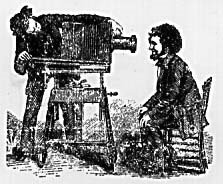Shutterbug Follies, written and illustrated by Jason Little, follows Bee, an 18 year old film developer living in New York. Her interesting days of film developing become even more interesting when Oleg Khatchatourian drops off film to be developed. Although used to being exposed to somewhat graphic pictures, Bee is horrified at the images she develops of murder victims for Oleg. Bee becomes suspicious that Oleg is not only photographing the murder scenes but causing them as well. She embarks upon her own private investigation, being aided with help from a girlfriend, a taxi driver, and an assistant of Oleg. Bee puts herself in danger by proving that Oleg indeed is a murderer only to find herself in a tight spot (in a file cabinet actually). With the help from her taxi driver friend, Bee manages to escape danger and Oleg is caught.
Because the storyline takes place in New York, the city and its inhabitants play a key role in the plot. The characters all seem to be somewhat stereotypic of those found in a city of New York. Taxi drivers, tattooed friends, immigrants in crime circles, and even ethnic cuisines are all typecasts of a cultural smattering in the city.
Shutterbug Follies is (from what I saw in Odegaard) one of the few graphic novels that uses color. The colors seem to parallel scenes—the dark room is red (danger), the store is green (perhaps mellow), and the night scenes/chase scenes are in muted tones. The book also presents film to look like film, pictures to appear as Polaroids or other styles of prints, and video surveillance shots to look like monitor screens.
announcements
This blog was created by and for students in an Introduction to Cultural Studies class at the University of Washington. Through an investigation of urban experience and representation--in theory, in graphic novels and in our own "readings" of Seattle's University District--we considered the formation and history of cultural studies as an (anti)discipline, with a special emphasis on the questions, "What does cultural studies do, and how do you do cultural studies?"
If you'd like to know more about the class, the blog or our U-District artifact project, please contact Gabrielle Dean: gnodean@u.washington.edu.
If you'd like to know more about the class, the blog or our U-District artifact project, please contact Gabrielle Dean: gnodean@u.washington.edu.
Subscribe to:
Post Comments (Atom)
blog archive
-
▼
2008
(92)
-
▼
May
(26)
- Seattle U District: City Artifacts Map
- City Artifacts: What and Where?
- Researching History and its Representations...
- Palestine
- Persepolis 1 & 2
- Shutterbug Follies
- A Scanner Darkly
- Maus I & II
- A Scanner Darkly
- Maus I & II
- Shutterbug Follies
- Persepolis 1 and 2
- Postcards: True Stories that Never Happened
- Maus I & II
- Postcards: True Stories that Never Happened
- Persepolis 1 & 2
- Mail Order Bride
- Mail Order Bride: Mark Kalesniko
- Persepolis 1 & 2
- Shutterbug Follies
- Maus I and II
- Palestine
- Postcards: True Stories That Never Happened
- PALESTINE
- Postcards: True Stores That Never Happened
- Shutterbug Follies
-
▼
May
(26)

No comments:
Post a Comment